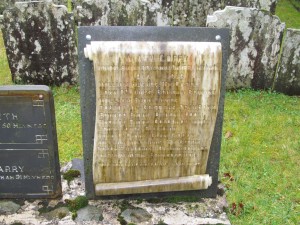Obituaries and Memorials to the Soldiers of Tregarth
Tregarth is a village in the Ogwen Valley, Caernarfonshire. Its Wesleyan Methodist chapel, ‘Shiloh’ and church, ‘St Mary’s’ are still open and have memorials dedicated to those who lost their lives in the First
World War. The church also holds the Sunday school’s memorial and a stained glass window dedicated to the Brock brothers, whose father was the headmaster of the local school. The gates to the church are also a memorial to those from Tregarth who died during both world wars.
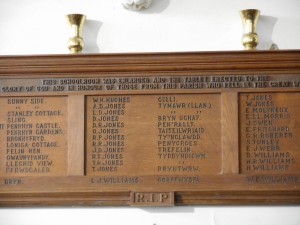 Shiloh’s memorial lists the names and homes of members of the congregation who died fighting the war (for example: Richard Jones – Tyddyn Dicwm). It was necessary to include the street or farm where the fallen had lived, as the community identified them by their place of residence rather than by their surname. Therefore, Richard Jones would probably have been known as Richard Tyddyn Dicwm. The gates outside St. Mary’s and the Sunday school memorial also note where the soldiers had lived in Tregarth. This was also important because a number of the soldiers had the same surname – there are 43 names on the Sunday school memorial, 13 of whom are ‘Jones.’
Shiloh’s memorial lists the names and homes of members of the congregation who died fighting the war (for example: Richard Jones – Tyddyn Dicwm). It was necessary to include the street or farm where the fallen had lived, as the community identified them by their place of residence rather than by their surname. Therefore, Richard Jones would probably have been known as Richard Tyddyn Dicwm. The gates outside St. Mary’s and the Sunday school memorial also note where the soldiers had lived in Tregarth. This was also important because a number of the soldiers had the same surname – there are 43 names on the Sunday school memorial, 13 of whom are ‘Jones.’
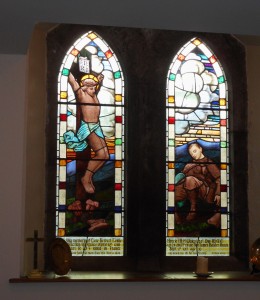
St. Mary’s memorial, by contrast, seems less concerned with remembering the soldiers as part of the local community, and more concerned with showing their important role in the Great War. The memorial does say where the soldiers lived. In the majority of cases it does not record the first names of the deceased. Instead, it lists their rank in the army; first initial; surname; area in which they fell and the year they died. The stained glass memorial to the Brock brothers in St. Mary’s echoes this focus on military accomplishments. Although we know from the Sunday school memorial that they lived at Sunnyside, the inscription on the stained glass makes no reference to this. It reads: ‘In loving memory of Lieut. Herbert Leslie Brock (BA Wales) 20th Div. MGC. Killed in action in France April 10th 1918 age 28, and Private Ivor James Baxter Brock 14th Batt. R. W. F. killed in France Sept. 1st 1917 age 19. “Greater love hath no man than this that a man lay down his life for his friends.” S. John XV 13.
Different memorials commemorated men in different ways, and the same can be said of newspaper obituaries. This project seeks (among other things) to analyse memorials from all over Wales to see if it is possible to identify patterns in their styles and wording. For example, was including the soldier’s home address on a memorial a trait unique to north Wales, or was it common across rural Wales? Did all Anglican churches note where and on what date members of their congregation had been killed in action? Further research also needs to be done on whether the religious denomination or political outlook of the newspapers had an influence on the style of obituary they published.
Below are examples of Tregarth men’s obituaries from three newspapers. Y Llan was a bilingual Anglican newspaper, whilst Y Gwyliedydd Newydd was Wesleyan. Y Genedl was more political than religious. It supported the Liberal party, but welcomed contributions which reflected the socialist point of view.
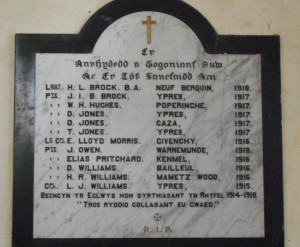
Both Y Llan and Y Genedl’s obituaries seem to stress that the fallen were brave men who had fallen for king and
county. Whilst Y Llan (28/4/1916, p. 7) extended its deepest sympathy to David Williams’s whole family, especially his widow, his young children and his mother, they believed that ‘ond y mae cysur i’w gael wrth feddwl ei fod wedi marw wrth wneud ei ddyletswydd’ (but there is comfort to be had in the thought that he has died doing his duty). A month later, Y Genedl (23/5/1916, p. 8) was even more emphatic that the soldiers were dying for a just cause. It’s article was about a memorial service to Richard Price Jones, but in the middle of the article it refers to all soldiers involved in the war: ‘Da gweled yr ardalwyr yn gollwng dagrau hiraeth, ac o barch, ar ôl y bechgyn sydd yn rhoddi eu bywydau i lawr i gadw y gelynion rhag gwneud ein gwlad fel Belgium, Serbia a Pholand.’ (It is good to see the locals shedding tears of loss and of respect for the boys who have given their lives to prevent the enemy from making our country like Belgium, Serbia and Poland.’) Richard Price Jones’s memorial service was held at the Calvinistic Methodist chapel in Tregarth, but unfortunately I do not know if the chapel is still in use or if any memorials are preserved there.
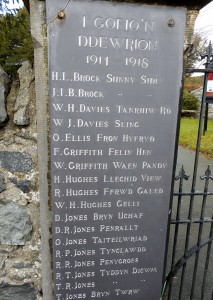
By contrast, the obituaries in Y Gwyliedydd Newydd seemed less certain that the Great War was a just cause that was worth the cost. It also acknowledged that not all soldiers on the battlefield wanted to be there. My research so far has not been very extensive, so the first obituary I found relating to a soldier from Capel Shiloh is from September 1916. Conscription had been introduced in March 1916, and attitudes towards the war in Britain as a whole were less fervently patriotic than in the hopeful days of 1914. Also, as Dafydd Roberts has explained in his article, ‘”Dros ryddid a thros ymerodraeth” Ymatebion yn Nyffryn Ogwen 1914-1918’ (“For Freedom and for Empire: reaction in the Ogwen Valley 1914-1918,’ Caernarvon Historical Society Transactions, 1988-9 p. 107- 123), the residents of the Ogwen valley had been reluctant to enlist since the outbreak of war. Methodism in pre-1914 Wales had a strong pacifist tradition, which may also have influenced the newspaper’s views about the war. Y Gwyliedydd Newydd’s coverage of Rowland Hughes’s memorial service (12/9/16, p. 6) refers to the battlefield as ‘faes y gyflafan ofnadwy’ (the field of awful massacre). When Owen Ellis was killed at the front, the paper (30/1/1917, p. 7) played with the phrase ‘maes y gad’ (battlefield) calling it instead ‘maes y gwaed’ (field of blood). By the time David Richard Jones was killed (2/7/1918, article published 24/7/1918, p. 8), Y Gwyliedydd Newydd was referring to the whole war as ‘y gyflafan erchyll yma’ (this horrific massacre).
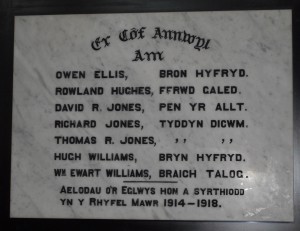
In two articles about members of Shiloh’s congregation who had died at the front, the paper makes it quite clear that they had not enlisted because they believed in the glory of war. The first, Rowland Hughes’s (12/9/16, p. 6), stated that he ‘Ymunodd a’r fyddin o argyhoeddiad dwfn. Methai a chysgu’r nos gan faint bwysai ar ei feddwl. Cychwynnodd i’r chwarel at ei waith, troes yn ei ôl, a cherddodd i Fangor i ymuno a’r fyddin, – “yr wyf i fod i listio, meddai, i ymladd dros gyfiawnder.” (He joined the army from deep conviction. He could not sleep at night because of the weight on his mind. He started towards his work at the quarry, turned around, and walked to Bangor to enlist in the army, – “I am going to enlist, to fight for justice”.) Although he had eventually decided to fight for his principles, the newspaper makes it clear that this was not an easy decision to make. The second example is Owen Ellis (30/10/17, p. 7). When describing his character, Y Gwyliedydd Newydd said he was: ‘un o’r bechgyn tyneraf ei ysbryd, a pharatoaf ei gymwynas. Er iddo farw’n filwr ar faes y gwaed, nid milwr mohono wrth anianawd. Yr oedd o duedd enciliedig, gwell ganddo wrando na llefaru. Er hynny, pan alwyd arno i gyflawni’r annymunol gwnaeth hynny yn ffyddlon a theyrngarol. Da gennym glywed gan ei Gaplan iddo farw fel y bu fyw, yn llawn arwriaeth.’ (He had one of the gentlest souls, and was always happy to help. Although he died a soldier on the field of blood, he was not a soldier at heart. He was of a retiring nature, preferring to listen than to preach. Despite this, when he was called upon to do the objectionable he did that faithfully and loyally. We are glad to hear from his Chaplain that he died as he lived, full of heroism.) Although this extract refers to Owen ‘doing his duty’ and ‘dying a hero’ it also, I think, makes it explicitly clear that he should not have died ‘on the field of blood.’
This article has only looked very briefly at the some of the memorials in one village. There is far more scope for others to find out more about the memorials and obituaries in their own local communities.
Meg Ryder April 11th, 2016
Posted In: chapels / capeli, memorials
Tags: Dyffryn Ogwen, Tregarth
WW1 Memorial in Y Tabernacl, the Welsh Baptist chapel in Cardiff
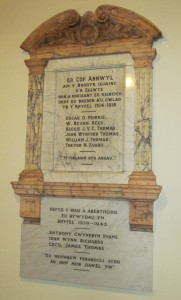 On a wall inside the Tabernacl, the Welsh Baptist chapel on the Hayes in central Cardiff, there is a memorial to the six men of the congregation who died in the Great War.
On a wall inside the Tabernacl, the Welsh Baptist chapel on the Hayes in central Cardiff, there is a memorial to the six men of the congregation who died in the Great War.
The memorial itself is impressive, being carved in marble.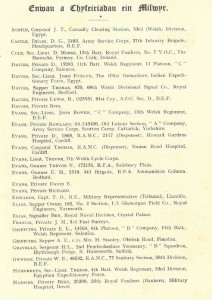
There are no records to indicate whether the chapel displayed a ‘Roll of Honour’ as the war was being fought, to highlight the contribution of a large number of the congregation to the war effort. However, the chapel’s Annual Reports do note the names of all the men who enlisted, and so we can trace how the war had a deeper effect every year on the congregation. There were 45 names on the list at the end of 1915, 62 by the end of 1916 and 66 in 1917 (including four who had been killed). The membership of the Tabernacl during the war fluctuated from around 520 to 560, so the total of 66 represents a sizeable proportion of the young male membership of the church.
List of chapel members serving in 1916
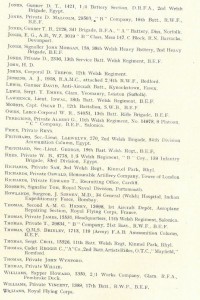
We can also see how the War’s impact became deeper and more painful from the minister’s comments in the reports. At the end of 1914 there was more discussion about the fire that had damaged the chapel than about the War, but the Rev Charles Davies’ comments became ever more emotional as the war dragged on and took an ever-increasing number of young men from his flock. Looking back upon 1916, he wrote that the young men left a large gap, and that their valuable contribution to the life of the chapel was deeply missed by those who were left. However, there is no doubt that the minister considered the war to be just, as he used such words as ‘teyrngarwch’ (loyalty), ‘dewrder’ (courage) and ‘aberth’ (sacrifice) to describe the men’s contribution to the war effort. He declared that as they faced the dangers and discomforts of the war, they were fighting ‘er amddiffyn ein gwlad, a sicrhau buddugoliaeth i gyfiawnder a gwir rhyddid yn ein byd’ (to defend our country, and to ensure a victory for justice and for the true freedom of our world).
In the lists of the men there is information about where a number of them were serving. At the end of 1916 a large number were in training camps in England or Wales; 14 with the BEF (British Expeditionary Force) on the Western Front; six in Egypt; four in Salonica and one in Bombay.
The first name on the memorial is Oscar D. Morris. It is possible to find a great deal of information about him: the letter he wrote as he sought to join the Welsh Army Corps are available on the Cymru1914 website – http://cymru1914.org/en/view/archive/4089505
One can also find a report on his promotion to lieutenant (August 1915 – http://cymru1914.org/en/view/newspaper/3886208/7/ART121) and then reports on his death on the Western Front on 21 April 1917 (http://cymru1914.org/en/view/newspaper/3886989/1/ART11 and http://cymru1914.org/en/view/newspaper/3886999/3/ART35 ). 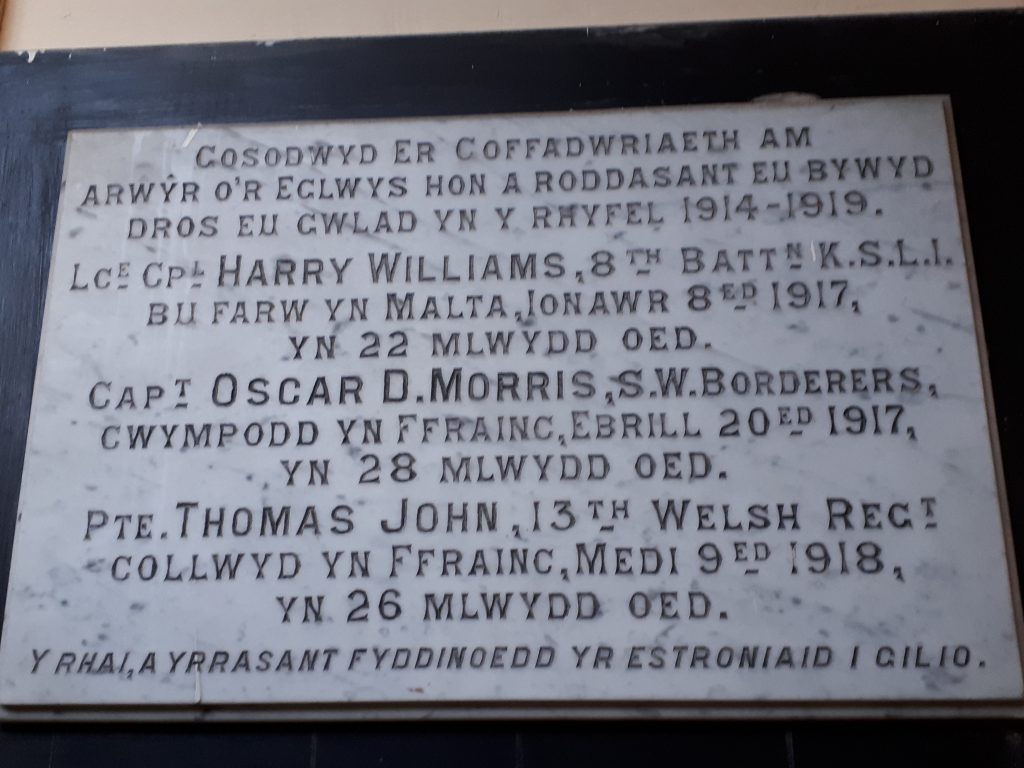
Oscar’s name is also to be found on the memorial in his home chapel – Salem Nantyffyllon.
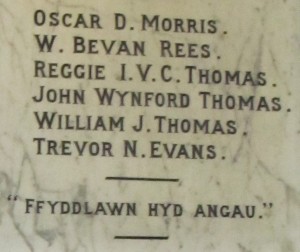 The second name is W. Bevan Rees, originally from Llandybïe, Carmarthenshire (who was 20 years old and working as a miner at the time of the 1911 census). He died in Palestine on 3 November 1917.
The second name is W. Bevan Rees, originally from Llandybïe, Carmarthenshire (who was 20 years old and working as a miner at the time of the 1911 census). He died in Palestine on 3 November 1917.
Reggie I.V.C.Thomas is the next name: he died on 24 November 1917 aged 19, while serving on the Western Front with the South Wales Borderers. He has no known grave, but his name is on the Cambrai memorial.
One can find John Wynford Thomas as a 12 year old boy in the 1911 Census, living in Lampeter Velfrey. There is no indication of when he moved to Cardiff, but he enlisted in the city, joining the South Wales Borderers. He was killed in Flanders on 31 October 1917.
Despite his common name, it is certain that the William John Thomas named on the memorial was an 18 year old who died on 11 July 1918 while serving with the Army Service Corps. He is buried in Cathays Cemetery, Cardiff.
However, the final name on the memorial is not on the list of the Commonwealth War Graves Commission. According to the Tabernacl’s records he was a soldier in 1916, serving as a Gunner with the RFA (Royal Field Artillery) on Salisbury Plain. The chapel’s report says that he died on 18 February 1919.
g.h.matthews March 22nd, 2016
Posted In: chapels / capeli, memorials, Uncategorized
Tags: chapels / capeli, memorials, WW1
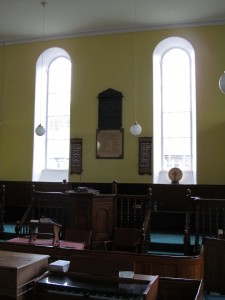 situated on the wall behind the pulpit, so that any worshipper who is looking at the minister will have the memorial in their line-of-sight.
situated on the wall behind the pulpit, so that any worshipper who is looking at the minister will have the memorial in their line-of-sight.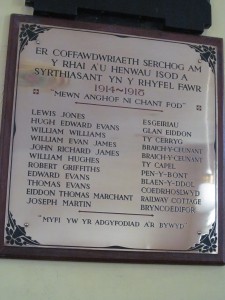 Esgeiriau
Esgeiriau